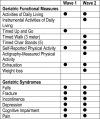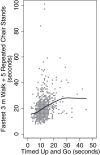Geriatric syndromes and functional status in NSHAP: rationale, measurement, and preliminary findings
- PMID: 25360019
- PMCID: PMC4303102
- DOI: 10.1093/geronb/gbu091
Geriatric syndromes and functional status in NSHAP: rationale, measurement, and preliminary findings
Abstract
Introduction: The geriatric functional measures and syndromes collected 5 years apart in Waves 1 and 2 of the National Social Life, Health, and Aging Project (NSHAP) data set included: difficulty with activities of daily living and instrumental activities of daily living, the timed up and go, a 3-m timed walk, repeated chair stands, self-reported physical activity, accelerometry-assessed (in)activity, falls, fractures, and frailty. The purpose of this paper was to describe the data collection methods and report preliminary population estimates for each measures.
Method: Frequencies, means, or medians were estimated for each measure stratified by age and gender, using the age-eligible samples in Wave 1 (n = 3,005) and Wave 2 (n = 3,196). An adapted phenotypic frailty scale was constructed in the sample common to both waves (n = 2,261). Changes over 5 years were reported for four measures common to both waves.
Results: The functional measures worsened with age (p < .001). The syndromes were more prevalent with age except "all fractures" (p value range < .001-.03). Functional measures were worse among females than males except chair stand performance and the accelerometry-assessed (in)activity measures (p value range < .001-.01). The syndromes were more common among females than males except Wave 2 falls and Wave 2 hip fractures (p value range < .001-.03). Changes from Wave 1 to 2 revealed 11.5%-25.2% of individuals reported better health and 21.3%-44.7% reported worse health.
Discussion: The NSHAP provides a comprehensive assessment of geriatric health. Our findings are consistent with the literature and support the construct of the study measures.
Keywords: Accelerometry; Falls; Fracture; Frailty; Functional assessment; Gait; Older adults; Physical activity..
© The Author 2014. Published by Oxford University Press on behalf of The Gerontological Society of America. All rights reserved. For permissions, please e-mail: journals.permissions@oup.com.
Figures
References
-
- Cheung V. H., Gray L., Karunanithi M. (2011). Review of accelerometry for determining daily activity among elderly patients. Archives of Physical Medicine and Rehabilitation, 92, 998–1014. S0003-9993(11)00045-1 [pii] 10.1016/j.apmr.2010.12.040 - PubMed
-
- Engelman M., Canudas-Romo V., Agree E. M. (2010). The implications of increased survivorship for mortality variation in aging populations. Population and Development Review, 36, 511–539 doi:10.1111/j.1728-4457.2010.00344.x - PubMed
Publication types
MeSH terms
Grants and funding
LinkOut - more resources
Full Text Sources
Other Literature Sources



